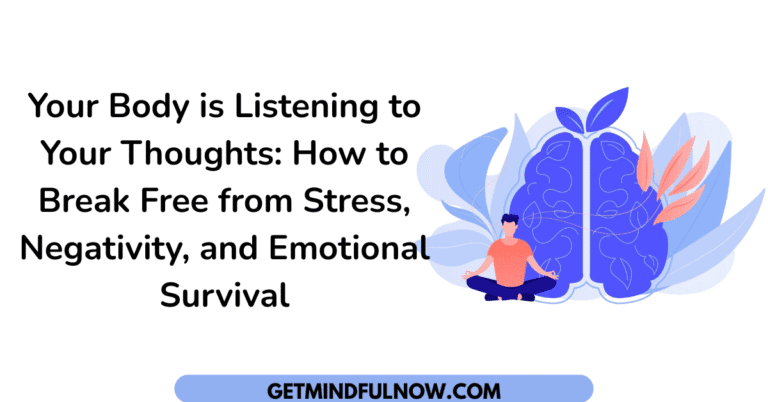You’re Not Stuck. Your Brain Just Thinks You Are.
Let me paint the real picture.
Most people wake up already exhausted, not from what they’ve done, but from the weight of who they believe they are. You get out of bed, check your phone, and instantly feel behind. You already know the day will be a repeat: the same stress, the same worry, the same emptiness. And no matter how much you tell yourself you’ll do better or feel different, it never really sticks.
You go to work or tend to the house, maybe take care of others, but inside you’re running on fumes. Every day, it’s like you’re chasing a version of yourself you can’t quite reach. You’ve read the books. You’ve made the future goals. You’ve even whispered affirmations when no one was looking. But deep down, it feels like your life is running on an autopilot you can’t seem to switch off.
I get it. I lived it. And let me tell you something radical:
You’re not stuck. Your brain is just stuck on the wrong settings.
The endless loop you feel trapped in isn’t who you are, it’s just who your brain has memorized you to be.
And the best part? You can change that program. I’m going to show you how, and it’s simpler than you’ve been led to believe.
But the best part? You can change that program. And I’m going to show you how.
Your Body Listens to Every Thought You Think (And Takes It Literally)
Here’s something most people never realize: your body doesn’t know the difference between what’s happening around you and what’s happening inside your head.
Every thought you think, every single one, sends a signal from your brain to your body. It’s like sending an email from your mind that your cells immediately act on.
It starts in the frontal lobe, the part of your brain that helps you make decisions, imagine possibilities, and focus. The moment you set an intention or think a thought, your brain creates chemical messengers called neuropeptides. These tiny messengers travel through your nervous system and tell your cells how to respond. Should they fire up stress hormones like cortisol? Or should they release feel-good hormones like oxytocin and DHEA?
That means:
- If you spend your day worrying, imagining worst-case scenarios, or replaying painful memories → your body literally bathes itself in stress chemicals.
- If you spend time focusing on gratitude, compassion, or possibilities → your body shifts to a state of healing, trust, and growth.
Your body is always listening. And it reacts to your thoughts as if they’re happening in real life.
This is how someone can sit in a perfectly safe room, imagine something stressful, and suddenly feel their heart race, palms sweat, and stomach tighten. The body responds to the mind, automatically.

And here’s the thing: your body gets used to whatever chemicals you feed it most. It’s like developing a taste for junk food. Before you know it, your system craves the very stress you say you want to escape.
That’s why change starts by becoming aware of the thoughts you let run the show, and practicing new ones, on purpose, until your body catches up.
The Science of How Your Brain Learns to Change (or Stay Stuck)
This is a reality about your brain: it’s never standing still. It’s either learning something new or getting better at staying the same.
Back in the 1990s, neuroscientist Eric Kandel showed that when you repeat something over and over, whether it’s a thought, an emotion, or an action, the brain literally grows new connections. The more you practice it, the stronger those connections get.
The opposite is also true: when you stop using certain thoughts or behaviors, the brain begins to prune away those old connections in as little as three weeks.
Think of it like this: your mind is a garden. Every thought you water grows. Every thought you ignore shrivels.
This ability to shape your own brain is called neuroplasticity, and it’s the reason people can overcome trauma, break toxic patterns, and even heal physical conditions when they commit to new ways of thinking and feeling.
But if you don’t use this power intentionally? Your brain just keeps replaying the same story it knows best.
That’s how people stay stuck without even realizing they’re doing it.
The key is to teach your brain new signals so your body can finally feel something different. And that’s what I’ll show you how to do.
Your Thoughts and Emotions Are Physical—Not Just Mental
This isn’t just theory, it’s physical.
The stress you feel when you ruminate on worst-case scenarios? That’s not just “in your head.” It’s cortisol, adrenaline, and inflammation wreaking havoc in your bloodstream.
The peace you feel when you practice gratitude? That’s not woo-woo. It’s oxytocin, dopamine, and DHEA, actual chemical signals telling your body to heal, relax, and thrive.
Your inner world creates measurable physical reactions. And you can flip that switch any time you choose.
Why We Get Addicted to Feeling Bad
Here’s where it gets wild: negative emotions can become an addiction, just like sugar, nicotine, or caffeine. But instead of craving something outside of us, we’re hooked on the emotional chemicals our own body is pumping out.
If you’ve spent years living in fear, sadness, guilt, anger, or resentment, your brain fires those emotional patterns so often that your body builds more receptors for them. Think of it like your cells getting better and faster at responding to misery.
After a while, your body literally expects those feelings. It’s like your system wakes up every day waiting for its “dose” of stress, frustration, or hurt. Even when the external situation changes, when you leave the toxic job, distance yourself from the harmful relationship, or move away from the place that triggered you, you still find yourself thinking, feeling, and reacting the same way.
That’s not because you’re broken. It’s because your brain-body loop has been running the same emotional software for so long, it’s operating on autopilot.
And this loop? It’s not just psychological, it’s chemical.
The more you feel bad, the more you stay in the stress zone. Your hypothalamus-pituitary-adrenal (HPA) axis keeps firing, your body keeps releasing stress hormones, and your cells keep soaking them up. That’s why, even in moments of calm, you might still feel uneasy, restless, or anxious for no clear reason.
The addiction to negative emotions is real. But like any habit, when you stop feeding it, it begins to lose its grip.
And this is where the real work starts: becoming aware of when you’re slipping into those familiar emotional states, and choosing, over and over, to fire something different instead.
It won’t feel natural at first. It won’t feel “true.” But the body doesn’t know the difference between what’s real and what’s rehearsed. What matters is what you practice.
The more you practice new emotional responses, peace, gratitude, strength, the more you shift your inner chemistry. And when your chemistry changes? So does your life.
The Chain Reaction: From Thought to Healing (or Hurting)
- Your frontal lobe sets an intention.
- That intention creates neuropeptides.
- These messengers tell your body how to respond, stress hormones or healing hormones.
- The more you practice, the faster your body adjusts its “set point” for stress or peace.
Yes, you can literally train your body to feel safe, calm, and vibrant again, on purpose.
But, and this is the part almost no one talks about, the moment you start changing your thoughts and emotions, your body will push back.
The first time you try to think differently, you might hear a mental avalanche:
- “I can’t do this.”
- “It’s impossible.”
- “It’s my parents’ fault.”
- “I’m too damaged.”
- “I don’t have the time, the money, the energy, the support.”
This is not just negative thinking. This is your body craving its old chemical cocktail, the familiar rush of stress hormones and survival emotions it’s used to. Your cells are literally signaling your brain to bring back the old feelings because, to your nervous system, familiarity equals survival.
It doesn’t matter that those old emotions made you sick, anxious, depressed, or exhausted. To the body, what’s familiar feels safe, even if it’s miserable. And what’s unfamiliar, like peace, joy, or calm, can feel terrifying, because uncertainty to the primitive brain feels like danger.
That’s why people sabotage their own healing. It’s not because they’re weak, it’s because the body fights to maintain chemical homeostasis.
Understanding this is everything.
When you start hearing those spiraling, self-sabotaging thoughts, you can pause, breathe, and remember: this is withdrawal, not truth. The more you practice choosing a new emotional state, the more you shift the chemical baseline. And when that shifts, everything changes.
Like any addiction, it’s uncomfortable at first. But withdrawal gives way to freedom.

The Power of Mental Rehearsal: How Your Mind Can Shift Your Biology
Before I share my personal story, I want you to hear something that can shake your idea of what’s possible:
In a famous study, a group of elderly people checked into a monastery designed to look exactly like it was decades earlier, the music, the décor, the daily conversations. For one full week, they “acted” as if they were 20 years younger.
By the end of that week, researchers measured significant improvements: their posture straightened, grip strength increased, mental clarity sharpened, and blood markers of aging shifted, just from living as if they were younger.

Their bodies changed because their minds rehearsed a different reality. The environment fed the new script, and their biology followed.
That’s the power of mental rehearsal.
When you combine new thoughts, new emotions, and new intentions, your body doesn’t know the difference between imagination and reality. The nervous system fires. Hormones shift. Gene expression changes. Healing begins.
And this isn’t just for people in labs. It’s for you. It’s for me.
My Personal Story: From Survival to Rewiring My Life
I didn’t learn this stuff because I wanted to. I learned it because I had to.
Years of chronic stress, emotional trauma, and feeling trapped in my own mind wrecked my health, my energy, and my happiness. I kept hoping things would change. I read the books. Did the affirmations. And still, I’d spiral back into the same stuck state.
Until I understood: my body was addicted to surviving, not living.
I started applying the exact science you’re reading here. I practiced daily stillness. I rewrote the story in my mind. I caught my old thought loops and replaced them over and over. It was messy, imperfect, and slow.
But it worked.
Today, my life, my mind, my health are completely different. Not because life got easier, but because I finally became the one in charge of my brain-body chemistry.
Testimonial 2
How to Start Rewiring: The Daily Practice That Changes Everything
You don’t have to overhaul your life overnight. You just need to start small and stay consistent.
1. Morning Reset: Brain in Alpha
- First thing after waking: no phone, no news. Just sit quietly.
- In this alpha state, your subconscious is open. Use it.
2. Set an Intention on Purpose
- Who do you want to be today? Calm? Confident? Peaceful? Strong?
- Say it. Picture it. Feel it.
3. Catch the Loops
- Throughout your day, notice the old thoughts when they pop up. Don’t fight them. Just name them.
4. Rehearse the Future
- In meditation or quiet moments, practice being the new you in your mind. Feel the emotion, not just the thought.
- Your brain doesn’t know it’s not “real.”
5. Feel It to Seal It
- Emotions wire it in. Practice gratitude, love, trust, because those chemicals teach your body the new state faster.

Why Consistency is the Secret Ingredient
Neurons that fire together, wire together. And the ones you ignore? They fade.
That’s why this isn’t about a one-time “aha.” Even with medication, the body needs weeks to reset. This work is no different.
You’ve spent years, maybe decades, being one version of yourself. Give yourself the gift of time to become the next one.
Even five minutes a day is enough to start.
You’re Not Broken. You’re Becoming.
If you’ve read this far, I know something about you: you’re not the person you were when you opened this post.
Your brain is already rewiring.
And if you let yourself practice, imperfectly, daily, gently, you can change your mind, your body, and your life.
It’s not magic. It’s you.
Join my newsletter for more science-backed tools, real talk, and practical ways to step into the self you’ve always known you could be.
Let’s change for good. Together.








